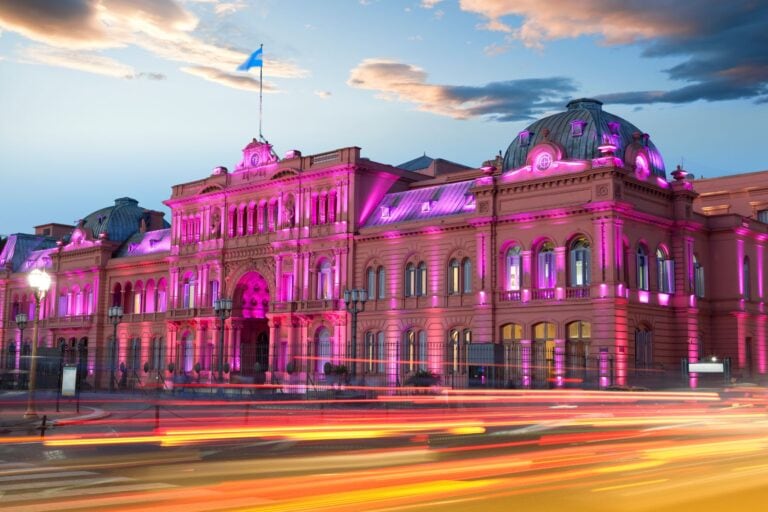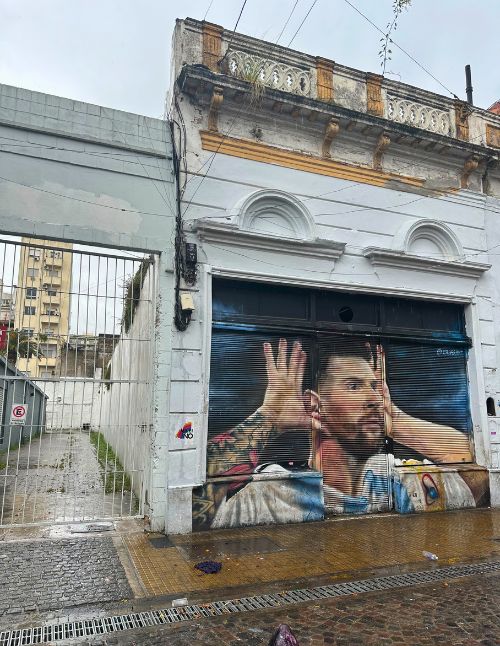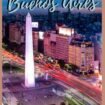
Go World Travel is reader-supported and may earn a commission from purchases made through links in this piece.
I had never been to Buenos Aires before nor anywhere else in South America. I did not even know whether to pronounce the “Aires” as Aries or Irez. Now I know – it is Irez!
Buenos Aires is a City of Contrasts
Buenos Aires is a contrast of barrios (neighbourhoods), of architecture, of colours and of weather. Over a few days, I experienced both searing sun and drenching rain. I saw barrios of grey and barrios of vibrant colour.
There were Parisian-style grand chateaux and brightly painted timber buildings. I saw boulevards and I saw narrow, cobblestone alleys. I saw lots of beautiful green space and I saw churches of different eras.
Everywhere I looked, I saw a sprinkling of purple. Jacaranda, which I had always assumed was native to Australia, was in full blossom. A quick Google and I learnt that jacaranda is actually native to South America! I was 7,218 miles (nearly 12,000 kilometres) from my hometown of Melbourne but both towns have their annual jacaranda display at the same time. Serendipity.
Sometimes known as the “Paris of South America,” Buenos Aires, is the capital of and most populous city in Argentina. It is also proudly the birthplace of tango. Argentina and Buenos Aires were once very wealthy places. This is still evident in certain barrios like Recoleta where I stayed. This affluent area is marked by grand, tree-lined boulevards and late 19th-century Belle Époque buildings.
Where to Stay

I stayed in the beautiful Alvear Palace Hotel which opened in 1922. The grand, central lobby was inspired by the great Ocean Liners of the time. Meals are served in an ornate hall of mirrors and Palladian-style windows and in an adjacent conservatory.
Waiters are dressed in smart, red jackets. Housekeeping staff are dressed in black dresses with white, frilly aprons.
Have a drink in the moody, marble and gilt lobby bar and you really feel transported to yesteryear.
Hop-On Hop-Off Sightseeing Bus
I travelled on the Hop-On Hop-Off sightseeing bus on the first day. This was a great way for a jet-lagged first-time visitor to get my bearings a little but the commentary wasn’t great.
The English narration is voiced by a non-native speaker. The unusual pronunciation coupled with a bad sound system meant that some of the commentary was unintelligible.
Regardless of the challenge of understanding the commentary, the bus was a great introduction to Buenos Aires and its diverse barrios and sites.
Read More: Gouchos and Estancias: Ranch Holiday in Argentina
Recoleta

The Hop-On Hop-Off Bus terminus is also opposite the Recoleta Cemetery. This Cemetery dates from 1822 and is full of marble mausoleums in many architectural styles.
Eva “Evita” Peron (nee Duarte) is one of the people buried there. Evita lies in the Duarte family mausoleum in a heavily fortified crypt some five metres underground.
There is a small admission fee to enter the Cemetery and the paths are all paved. I found the Cemetery a combination of beautiful, sad and eerie.
Also in Recoleta, wander to the El Ateneo Grand Splendid Bookshop, often referred to as the most beautiful bookshop in the world. This bookshop was formerly a theatre but now houses thousands of books, CDs and DVDs and a café. The café is actually situated on what was the stage, half shrouded in a red velvet stage curtain. You can pretend you’re performing if you like!
The building opened as a theatre in 1919 when Buenos Aires was booming economically. There are gorgeous frescoes on the soaring ceiling and ornate cornicing.
At the start of the 2000s, the theatre opened as a bookshop. Former theatre boxes now offer quiet reading nooks. There are not many English titles on offer but it is a wonderful building to visit and an inspired re-purposing of a historic building.
Move from La Recoleta to other barrios such as Palermo, San Telmo or La Boca and you could be in a different city. The neighbourhoods are that diverse.
Palermo

Palermo is the biggest barrio of Buenos Aires. I visited the area around Plazoleta Julio Cortazar which is known as Palermo Soho. Full of boutiques, bars and eateries, it lives up to the Soho name! Palermo is also the Polo capital of the world. Each year, in November, the city hosts the Argentine Polo Open commonly known as the Palermo Open.
Palermo also happens to be the birthplace of new President Javier Milei. Argentina’s dictatorship ended in 1983 and the country has been democratic since. Milei came to power in late 2023. He has a gargantuan task to tackle the crippling inflation plaguing Argentina.
Read More: Celebrating Christmas in Argentina
San Telmo

Changing gears from politics to food, walk the narrow, cobblestone lanes of San Telmo and head to Mercado de San Telmo. The Market dates from 1897. When I visited, it was full of locals eating and drinking.
After the hard decision of which eatery to choose for lunch, I chose a wood fire barbecue. Sitting on a stool at a counter looking at my lunch cooking, I was transfixed by the flames which were being continually stoked. Hot work for the cooks and delicious eating for me!
La Boca

Move to La Boca and see the football stadium plonked right in the middle of buildings. The colourfully painted stadium and surrounding buildings are a feast for the eyes. For the belly, there is more barbecue! I loved the vibrant La Boca but it did feel a bit seedy. I am not sure that I would want to be there late at night.
The terminus for the Hop-On Hop-Off Bus was less than a five-minute walk from the Alvear Palace Hotel – I actually stumbled on it by accident. I also bought tickets to a tango dinner and show at Gala Tango from the bus ticket window. I realised afterwards that the price I paid was much cheaper than the ticket price online.
Gala Tango

To be honest, I thought that the Gala Tango evening would comprise a fairly basic meal with a quick demonstration of tango. I was wrong – firstly, the restaurant in a cobblestone San Telmo street was lovely…fancy even, then the meal was terrific and the show was mesmerising.
Dinner was a choice of appetiser, main course and dessert with a bottle of wine between two. I couldn’t go past chorizo steak with chimichurri and an Argentine Malbec to drink. The show, which didn’t finish until 11:30 pm, was a combination of amazingly graceful and athletic Tango, singing and folklore.
Via the magic of the Uber app, I walked out the door and straight into an Uber.
Transportation Options
After the Hop-On Hop-Off bus day, I walked most places and, if the distance was too far, I Ubered. Buenos Aires does have public transport options – buses and trains – but I didn’t use them.
Floralis Generica, an Architectural Marvel

Something unique that I loved in Buenos Aires (and actually first sighted from the Hop-On Hop-Off bus) was the Floralis Generica – a sculpture made of steel and aluminium and located in Plaza de las Naciones Unidas.
It was a gift to the city by the Argentine architect Eduardo Catalano in 2002. The sculpture was designed to move, closing its petals in the evening and opening them in the morning. It looks up at the sky, weighs eighteen tons and is 75ft (23 metres) high.
It is an architectural and sculptural marvel and I found it dazzling. A few days after I admired it, it was sadly damaged by freak winds. I hope Buenos Aires has the funds to repair it.
Top Tips for Traveling in Buenos Aires
- Use credit/debit cards wherever you can as the exchange rate is far superior. We took some US dollars with us and only used them for tipping. Our credit cards were accepted everywhere even for small purchases.
- Ubers are really cheap.
- There are TWO airports in Buenos Aires – Ministro Pistarini International Airport, Ezeiza (EZE) and Jorge Newbery Airport, known as Aeroparque (AEP). We flew from Santiago to Buenos Aires on LATAM and landed at EZE but the LATAM flight a couple of weeks later from Buenos Aires to Santiago left from AEP. Very confusing and very easy to make a mistake. CHECK and double-check and make sure you go to the right airport.
- The best time to visit Buenos Aires is spring and fall (known as autumn in Australia). Buenos Aires is in the Southern Hemisphere so remember that spring falls between September and December and fall is between April and June.
If You Go:
Read More:
Author Bio: Leonie Jarrett lives mostly in Melbourne, Australia with her Husband of more than 3 decades, her 4 adult children and her 2 Golden Retrievers. Leonie has variously been a lawyer and a business owner. Now that she is semi-retired, Leonie is loving writing about her life and her travels.
- Discover Claremont, California Along Historic Route 66 - December 6, 2024
- Three Sites to Soothe the Soul in Kyoto, Japan - December 5, 2024
- 13 Essential Tips For Women Traveling in Morocco - December 4, 2024


You make me feel I’ve been there! Thanks, Leonie.